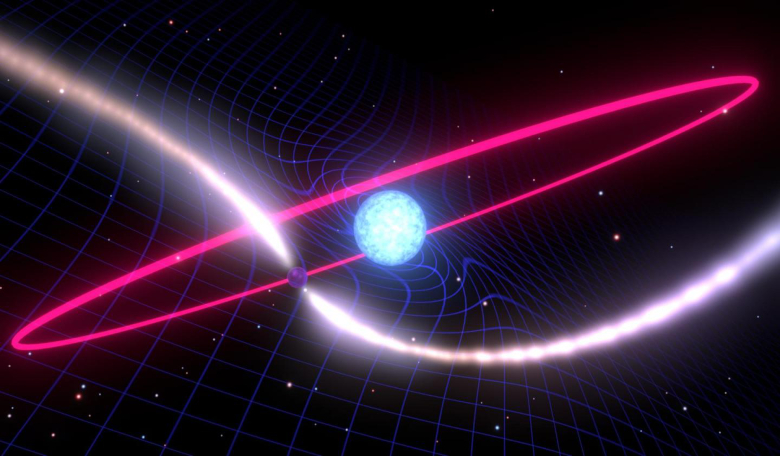Over a century ago Einstein predicted in his iconic theory of General Relativity that rotating bodies in space should 'drag' the very fabric of space time around with them; a phenomena known as 'frame-dragging’ or the Lense-Thirring effect and now after a twenty year study watching a celestial dance between a white dwarf and a neutron star, a team of scientists have been able to prove that once again, Einstein was right.
Searching for this effect is not a new concept. Frame-dragging has already been detected by satellite experiments in the gravitational field of the rotating Earth. However because of the size of the objects in question, its effect is tremendously small and challenging to measure.
What scientists needed were more massive objects so that they could observe the phenomenon under a more intense gravitational field.
So, almost twenty years ago, a team led by Swinburne University of Technology's Professor Bailes – director of the ARC Centre of Excellence in Gravitational Wave Discovery (OzGrav) – pointed the CSIRO Parkes 64-metre radio telescope at a pair of incredibly dense objects that later became known as the ‘PSR J1141-6545’ system.
This system is made up of a white dwarf the size of Earth but around 300,000 times its density and the other is a neutron star. A neutron star is the collapsed core of a giant star and these small but ultradense remnants are 100 billion times the density of the Earth while only being approximately 20 kilometres in diameter.
After years of measuring the arrival times of the pulse signals sent hurtling through space by the young pulsar as it spun round in a tight, fast orbit with its massive white dwarf companion, lead author of the current study, Dr Vivek Venkatraman Krishnan (from Max Planck Institute for Radio Astronomy - MPIfR) began unraveling the relativistic effects at play in this cosmic cavort as part of his PhD at Swinburne University of Technology.
The pulses were measured to an accuracy within 100 microseconds as they arrived at Earth, allowing the team to identify a long-term drift in the system’s orbital parameters.
Pulsars are cosmic clocks, says Krishnan. “Their high rotational stability means that any deviations to the expected arrival time of its pulses is probably due to the pulsar's motion or due to the electrons and magnetic fields that the pulses encounter.”
At first the stellar pair appeared to exhibit many of the classic effects that Einstein's theory predicted says Krishnan. Then a gradual change in the orientation of the plane of the orbit was noticed, which caused the team to look at the problem from a different perspective.
“After ruling out a range of potential experimental errors, we started to suspect that the interaction between the white dwarf and neutron star was not as simple as had been assumed to date,’ says Willem van Straten a co-author of the study at Auckland University of Tech.
After eliminating other possible causes of this drift, Krishnan and colleagues concluded that what they were looking at was the result of Lense-Thirring effect due to the rapidly rotating white dwarf companion. Their work is now published in the prestigious journal, Science.
This is the first time that the effect, named after Austrian mathematicians Josef Lense and Hans Thirring who published their hypothesis three years after Einstein published his Theory, has been confirmed using the arrival time of radio pulses from a stellar system and is 100 million times stronger than that seen in satellites in orbit around the Earth.
It is also especially pleasing for team members Bailes, van Straten and Ramesh Bhat (ICRAR-Curtin) who have been regularly trekking out to the Parkes telescope since the early 2000s, patiently mapping the orbit with the ultimate aim of studying Einstein's Universe. 'This makes all the late nights and early mornings worthwhile', said Bhat.











